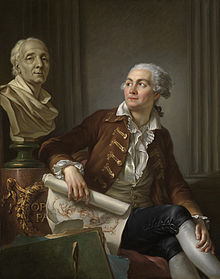Jean-Simon Berthélemy

Jean-Simon Berthélemy (5 March 1743 – 1 March 1811) was a French history painter who was commissioned to paint allegorical ceilings for the Palais du Louvre, the Luxembourg Palace and others,[1] in a conservative Late Baroque-Rococo manner only somewhat affected by Neoclassicism.
Biography


Berthélemy was born in Laon, Aisne, the son of a sculptor, Jean-Joseph Berthélemy,. He trained in the atelier of Noel Hallé, a professor at the Académie royale de peinture et de sculpture and made his first reputation in the 1760s; after reaching second place in 1763, he won the Prix de Rome of the Académie in 1767. An early commission was for a suite of decorative paintings under the direction of the architect Jean-Gabriel Legendre for the Hôtel de l'Intendance de Champagne at Châlons-sur-Marne, of which the artist only completed six overdoors, much in the manner of François Boucher and delegated the rest of the commission to a fellow pupil at the Académie.[2]
Berthélemy's master Hallé provided cartoons for the royal tapestry manufacture of the Gobelins, where he was appointed superintendent in 1770; Berthélemy was called upon to provide cartoons for the weavers as well. His Death of Etienne Marcel (1783) of which the oil sketch survives, was woven in the series Histoire de France.[3]
Career
Berthélemy was an esteemed painter in his day, chosen to join the entourage accompanying Napoleon's campaign in Italy, where he was among the experts assigned the task of selecting works of art to be transferred to Paris under terms of the Treaty of Tolentino, February 1797. He died in Paris. When two monographs on Berthélemy were published in 1979,[4] Philip Conisbee, reviewing them in The Burlington Magazine,[5] observed drily, "Two monographs on Berthélemy is overkill for a painter who could have been dispatched with a single substantial article. The French academic system of art education in the eighteenth century, backed up by the stimulus of church and state patronage, was so efficient and rigorous that even an average talent could be sufficiently conditioned to produce a handful of decent history-paintings, which are sometimes minor masterpieces."
- Paintings
-
Gladiator
-
Alexander Cuts the Gordian Knot (École des Beaux-Arts, Paris)
-
The burgers of Calais
-
Jupiter and Antiope
Notes
- ^ Christiane de Aldecoa, "L'Aurore et le Crépuscule ou la Brune, deux esquisses retrouvées : Jean-Simon Berthélemy (1743-1811) et les décors de plafonds", Les Cahiers d'Histoire de l'Art 4 (2006).
- ^ Five remain in situ in the Grand Salon of the Préfecture; one was sold in the Alberto Bruni Tedeschi collection at Sotheby's 21 March 2007.
- ^ An example of the woven tapestry after this design, still in official hands, is at the Faculté de Médecine, Paris (Ministère de la Culture: Inventaire).
- ^ Marc Sandoz, Jean-Simon Berthélemy (Paris: Editart Quatre Chemins), and Nathalie Volle, Jean-Simon Berthélemy, peintre d'histoire (Paris: Arthena).
- ^ Conisbee in The Burlington Magazine 123 No. 939 (June 1981): 369




